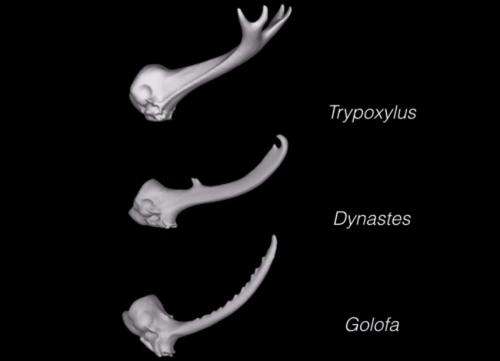September 9, 2014 report
Study shows rhinoceros beetle horns evolved to accommodate species-specific fighting styles

(Phys.org) —Male rhinoceros beetles have elaborate horns, which they use when fighting for mates. The shape and number of horns differ from species to species. Erin McCullough of the University of Montana at Missoula and her colleagues have discovered that horns evolved to have shapes that best suit each species' fighting style. The research appears in the Proceedings of the National Academy of Sciences.
Considered the strongest animals in the world, male rhinoceros beetles compete for females by attempting to remove their opponents from trees and shoots and throw them onto the ground. They use their horns as weapons. Horns come in a wide variety of shapes.
McCullough and her team wanted to find out why so many different horn types had evolved. They did not find any evidence that females chose mates based on horn size or shape, so they hypothesized that horn shapes evolved to improve fighting ability. Previous studies on the horns and antlers of ungulates supported this hypothesis. Among ungulates, males with long horns tend to fence or wrestle, males with curved horns tend to ram and males with short, smooth horns tend to stab.
To see if rhinoceros beetles also had horns suited to their particular fighting styles, the team used a type of computer modeling system, known as finite element analysis, to calculate the stresses and strains the horns would experience when used for different methods of fighting. They studied three species: Trypoxylus dichotomus, Golofa porteri, and Dynastes hercules.
All of these species have differently shaped horns, which they use in different ways. Trypoxylus has pitchforked-shaped horns that it uses to pry and twist opponents off tree trunks and branches. Golofa has long, slender horns that it uses like fencing swords, lifting opponents and throwing them off balance when fighting on narrow shoots. The head and thoracic horns of Dynastes form pincers, which the beetle uses to lift and squeeze opponents, then toss them to the ground. Models showed that a species' horns experienced the least stress and strain under conditions that mimicked species-typical fights.
The team predicted the cross-sectional shapes of the horns of each species, considering which shapes would maximize the ability to dislodge opponents, using that species' style of fighting. They thought cross sections of Trypoxylus horns would be triangular, those of Golofa would be circular and those of Dynastes would be elliptical. Microcomputed tomography scans proved their predictions correct. The team suggests researchers perform further studies on the effect of horn shape on other measures of fighting performance, such as grip and stability.
More information: Structural adaptations to diverse fighting styles in sexually selected weapons, Erin L. McCullough, PNAS, DOI: 10.1073/pnas.1409585111
Abstract
The shapes of sexually selected weapons differ widely among species, but the drivers of this diversity remain poorly understood. Existing explanations suggest weapon shapes reflect structural adaptations to different fighting styles, yet explicit tests of this hypothesis are lacking. We constructed finite element models of the horns of different rhinoceros beetle species to test whether functional specializations for increased performance under species-specific fighting styles could have contributed to the diversification of weapon form. We find that horns are both stronger and stiffer in response to species-typical fighting loads and that they perform more poorly under atypical fighting loads, which suggests weapons are structurally adapted to meet the functional demands of fighting. Our research establishes a critical link between weapon form and function, revealing one way male–male competition can drive the diversification of animal weapons.
Journal information: Proceedings of the National Academy of Sciences
© 2014 Phys.org





















